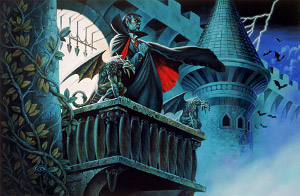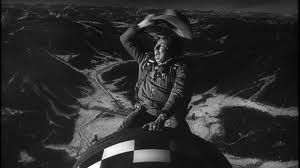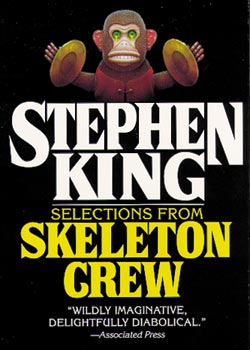The story: “Popsy,” collected in Nightmares and Dreamscapes. Published in 1993. Wikipedia entry here.
Spoiler-filled synopsis: To pay off his gambling debts, a man named Sheridan has resorted to abducting children at the behest of an unsavory crime lord. He has no way of knowing that his latest abductee is the son of a vampire, and that the vampire will want his son back. Ultimately, everybody gets what they deserve.

Like this, but imagine that the castle is actually a Nordstrom’s.
I’ve often wondered how authors who are parents manage to write stories in which children are endangered or killed. (King was the father of three children when this story was published.) Are such authors simply unaffected by the paralyzing dread that strikes me when I imagine hurt done to any child, much less my own? Do they force themselves to do it for the sake of their craft, because they know how powerfully such themes resonate? I don’t know where King finds the courage or the gall to write of such things, but I’ll readily admit it’s made for some of his strongest, most affecting work (It and Pet Sematary, among others).
And then there’s this story, written from the point of view of a child abductor. One thing about King is that he writes losers remarkably well—drunks, has-beens, and washed-up failures turn up often in his stories, sometimes as heroes and sometimes as villains. Here, the story’s loser protagonist (a gambling addict who got in over his head) would be sympathetic if it weren’t for the particular crime he turned to in order to save his skin. Sheridan is a sad and pathetic figure; and impossibly, we almost feel sorry for him here. As I suppose most such criminals do, he has walled up his guilt behind a lot of denial (“Hell, he wasn’t a monster or a maniac, for Christ’s sake,” King writes at one point).
But he kidnaps kids, and that’s enough to earn him his grisly fate. His latest victim is a young boy (albeit one with surprising strength, and weirdly sharp teeth) who keeps yammering on about his “Popsy” rescuing him. As he adds details (Popsy’s going to be mad… Popsy’s really strong… Popsy can fly…) we start suspecting that Popsy might not be your typical suburban dad. Before Sheridan can ferry the boy to his unspeakable criminal rendezvous, Popsy appears (bats, cape, the whole Dracula thing), rips Sheridan out of his creeper van, and feeds him to his vampire son.
While the child abduction is the most obviously shocking thing about this story, what’s actually most interesting is King’s portrait of the vampire as a 20th-century American. Popsy appears to be a magisterial Bram Stoker vampire, but Sheridan crosses paths with him not in a gothic castle or haunted moor but in a shopping mall. The vampire had brought his son to the mall (he tells Sheridan before tearing his throat out) to buy him a Teenage Mutant Ninja Turtle action figure. King loves to “postmodernize” the supernatural by tying it to the trivial mundanities of American life. He often does this by putting crude American slang in the mouths of even his most horrific supernatural villains; here it’s by imagining the lords of the night as just another bunch of American consumers looking to save big bucks at JC Penney and Toys ‘R’ Us.
It’s a little hard to recommend this story, but I won’t deny that there’s a sick appeal in reading about a child abductor Getting What’s Coming To Him. Would that justice in real-life kidnapping cases were as swift and terrible. There, see, now I’m feeling depressed again.
Next up: “Rainy Season” from Nightmares and Dreamscapes, which had better not involve imperiled children.

 Spoiler-filled synopsis: In the darkest days of the Cold War, a hyper-intelligent scientist discovers a chemical that removes all violent instincts from anyone who ingests it. He manages to spread the chemical across the globe, bringing about world peace… but unwittingly also dooming humanity, because an unanticipated side effect of the drug is the Alzheimer’s-like mental degeneration of everyone exposed to it.
Spoiler-filled synopsis: In the darkest days of the Cold War, a hyper-intelligent scientist discovers a chemical that removes all violent instincts from anyone who ingests it. He manages to spread the chemical across the globe, bringing about world peace… but unwittingly also dooming humanity, because an unanticipated side effect of the drug is the Alzheimer’s-like mental degeneration of everyone exposed to it.
 Spoiler-filled synopsis: A suburban man hires somebody to mow his lawn. Unfortunately, this particular lawnmower man is a
Spoiler-filled synopsis: A suburban man hires somebody to mow his lawn. Unfortunately, this particular lawnmower man is a 
 My thoughts: This is a sweet, sad little story told in the form of a screenplay. Given the close association of King’s written work with film, it seems appropriate to find a King-written screenplay tucked in here amidst his more traditional short stories.
My thoughts: This is a sweet, sad little story told in the form of a screenplay. Given the close association of King’s written work with film, it seems appropriate to find a King-written screenplay tucked in here amidst his more traditional short stories.